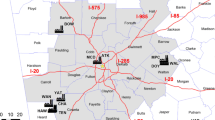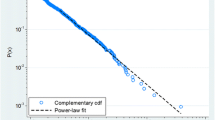Abstract
This work describes the development and application of a statistical model that links electricity generating unit (EGU) and mobile source emissions with a city center monitoring cite. The model uses estimated emissions and measured concentrations over the period 2000–2012 in Atlanta, GA, USA to develop counterfactual time series of daily ozone concentrations. Further, the model estimates the sensitivity of observed ozone to each emissions sector. Results show that emissions control policies have had little effect on annual median ozone, have decreased 90th percentile ozone, and have increased 10th percentile ozone. Sensitivities to EGU and mobile emissions are compared and agree well with similar sensitivities calculated using a first-principles chemical transport model.
Access provided by Autonomous University of Puebla. Download conference paper PDF
Similar content being viewed by others
Keywords
These keywords were added by machine and not by the authors. This process is experimental and the keywords may be updated as the learning algorithm improves.
1 Introduction
Air pollution controls are costly, and improved public and environmental health serve as justification for these controls. There has been increased interest in investigating the accountability of these controls in terms of providing their anticipated air quality and health benefits. In this research, funded by the Health Effects Institute, we investigate the links between past regulatory actions, meteorology, ambient air pollution concentrations, and health outcomes in Atlanta, Georgia, USA.
Legal basis for quality regulations in Atlanta are grounded in the 1990 Clean Air Act Amendments. Since this time, the United States Environmental Protection Agency (US EPA) has promulgated a number of regulations aimed at reducing the number of negative health effects attributable to ambient exposure. This research focuses specifically on the impacts on ambient concentrations of air pollutants of the following regulations: the Acid Rain Program (1995), the Tier 2 Vehicle and Gasoline Sulfur Program (2004), the Heavy-Duty Highway Rule (2007), the Clean Air Interstate Rule (2008).
This study demonstrates the formulation of statistical models to relate concentrations in Atlanta to estimated emissions after accounting for effects of meteorological fluctuations in ambient concentrations. Previous methods to estimate the sensitivities of air pollution levels have used chemical transport models (CTMs), using both brute force (e.g. Digar and Cohan 2010) and direct methods (e.g. Dunker 1981) (1,2). CTMs have the benefit of explicitly including information on atmospheric chemistry and physics, but generally take more time and computational resources to run.
Statistical models developed here are applied to estimated changes in emissions due to control actions to develop counterfactual time series of air pollution concentrations. Counterfactual concentrations allow for the quantification of the difference in air quality metrics that can be attributed to recent control actions implemented in the region. The comparison of results from statistical modeling and a regional CTM provides evidence that statistical methods are a viable method to estimate relationships between emissions sources and observations.
2 Method
Data used for this work is from the SouthEastern Air Research and Characterization (SEARCH) network’s Jefferson Street Station located in downtown Atlanta (33.77ºN, 84.41ºW) (Atmospheric Research and Analysis 2014). Daily metrics of ozone, PM2.5, NOx, and various meteorological parameters were developed from hourly measurements over 13 years (2000–2012). Daily emissions of NOx and SO2 from 14 electricity generating units (EGUs) in Atlanta’s nonattainment area were downloaded from the EPA’s Air Markets Database. EPA’s Mobile Vehicle Emissions Simulator (MOVES2010b) was used to estimate daily emissions of NOx, PM2.5, and Volatile Organic Compounds (VOCs) from mobile sources.
Nonlinear filtering and regression detrending based on a Taylor Series decomposition are used to meteorologically detrend ambient air pollution concentrations using methods similar to Kuebler et al. (2001). Each daily air pollution metric time series is detrended into 5 components: long-term (period > 365 days), seasonal (period = 365 days), weekly (period = 7 days), short-term (period < 365 days), and white noise (period = 1 day). Kolmogorov-Zurbenko (1991) filtering and regressions against meteorological variables (wind speed, temperature, relative humidity, rainfall, and solar radiation) are used to quantify fluctuations at each period, and the short-term component is removed from the ambient concentration signals, leaving fluctuations that are not associated with meteorological fluctuations (Henneman et al. 2015).
The detrended signals \(\left( {C_{det} } \right)\) are then used as the response in the following linear model:
where E is a matrix of estimated daily emissions from EGUs and mobile sources in the Atlanta area. The models parameters \(\beta\), which give the relationships between measured concentrations and emissions, are termed sensitivities. Sensitivities are combined with estimates of changes in emissions attributable to controls to estimate the magnitude of the observed concentration avoided (or added) by specific controls. In the case of some pollutants–particularly ozone–reduced emissions of precursors can lead to increases in ambient concentrations. This amount is then combined with observed concentrations to calculate a counterfactual time series of concentrations for each pollutant. These are used to assess the effectiveness of each regulation at reducing ambient air pollution concentrations.
The empirical sensitivities provide a point of comparison with related sensitivities calculated in regional chemical transport models. Results from the statistical modeling are compared to results from CMAQ-DDM (Community Multiscale Air Quality Model with the Decoupled Direct Method).
3 Results
Detrended annual average concentrations of NOx, CO, and SO2 each fell more than 50 % between 2000 and 2012. Total PM2.5 concentrations fell by 47 %, and this reduction was driven in part by decreases in sulfate, organic carbon, and elemental carbon aerosols over this period. Median ozone levels, meanwhile, have changed very little across the study period. Instead, the highest ozone concentrations have decreased while the lowest concentrations have increased.
Ozone sensitivities to total NOx emissions (Empirical STOT) included in the statistical modeling show a dependence on ozone concentration (Fig. 23.1). This corroborates findings by Liao et al. (2008), which showed that CMAQ-DDM sensitivities in Atlanta have a linear relationship with ozone concentrations (Liao et al. 2008).
Annual median counterfactual ozone does not differ much from the observed (Fig. 23.2). The spread of the annual distributions, however, increases drastically. This is expected due to the observed shrinking of the annual distributions that have been a consequence of reducing ambient concentrations of ozone precursor pollutants. In 2012, for example, changes in emissions are estimated to have reduced 90th percentile ozone from 109 ppb to 65 ppb, and 75th percentile ozone from 84 ppb to 55 ppb. 50th percentile ozone is estimated to have decreased by 4 ppb.
4 Discussion
Air pollution regulations that target ozone in the United States are written to penalize the highest ozone values. In this regard, these regulations have been successful. Even though median ozone has not changed and lowest values have increased, the highest levels have decreased substantially compared to counterfactual. This is due to the nature of the ozone response to emissions of precursors in Atlanta. On days with high ozone, a reduction in NOx leads to a reduced ozone concentration (NOx limited). However, on days with low ozone, a reduction in NOx causes an increase in ozone (reduced NOx titration).
The agreement between sensitivities estimated by the statistical modeling here and those calculated by CMAQ-DDM provide further evidence that the two approach reality. This work shows that statistical models are an alternative method to computationally intensive CTMs, and are feasible to run for long time series. The drawback of these models is that they are limited by the availability of observations of ambient concentration, meteorology, and emissions estimates. Further, similar to CTMs, they are limited by the accuracy of emissions estimates used to drive the calculations.
The daily results calculated using statistical methods based on observations provide an opportunity to assess whether changes in total exposure to ozone has an effect on negative health impacts using epidemiological analyses. This project is being performed with the aim of estimating the number of negative health effects that have been avoided due to regulatory actions implemented in Atlanta.
5 Key Findings
Ambient pollution trends show that concentrations of primary pollutants have decreased since 2000 after accounting for variability due to meteorological fluctuations. Long (13 year) time series of ambient concentrations are linked to estimated emissions from electricity generating units and mobile sources through statistical modeling. The parameters from the statistical modeling are the sensitivities of ambient pollution to emissions, and are compared to similar sensitivities calculated by CMAQ-DDM. Highest concentrations of ozone have decreased due to the policies, but median values have been resistant to change as low ozone values have increased.
References
Atmospheric Research and Analysis (2014) http://www.atmospheric-research.com/studies/ SEARCH/index.html
Digar A, Cohan DS (2010) Efficient characterization of pollutant-emission response under parametric uncertainty. Environ Sci Technol [Internet] 44(17):6724–6730. http://www.ncbi.nlm.nih.gov/pubmed/20701284. Accessed 1 Sep 2010
Dunker A (1981) Efficient calculation of sensitivity coefficients for complex atmospheric models. Atmos Environ [Internet] (1). http://www.sciencedirect.com/science/article/pii/000469818190305X. Accessed 7 May 2014
Henneman L, Holmes H, Mulholland J, Russell A (2015) Meteorological detrending of primary and secondary pollutant concentrations: methods application and evaluation using long-term (2000–2012) detailed data. Atmos Environ. http://www.sciencedirect.com/science/article/pii/S1352231015302521
Kuebler, Jerome, Hubert van den Bergh, Armistead, Russell G (2001) Long-term trends of primary and secondary pollutant concentrations in Switzerland and their response to emission controls and economic changes. Atmos Environ 35(8)(January):1351–1363. 10.1016/S1352-2310(00)00401-5 http://linkinghub.elsevier.com/retrieve/pii/S1352231000004015
Liao K-J, Tagaris E, Napelenok SL, Manomaiphiboon K, Woo J-H, Amar P et al (2008) Current and future linked responses of ozone and PM2.5 to emission controls. Environ Sci Technol [Internet] 42(13):4670–4675. http://www.ncbi.nlm.nih.gov/pubmed/18677989. Accessed 1 Jul 2008
Zurbenko IG (1991) Spectral analysis of nonstationary time series. Int Stat Rev 39:163–173
Acknowledgments
This material is based upon work supported by Health Effects Institute and the National Science Foundation Graduate Research Fellowship under Grant No. DGE-1148903.
Author information
Authors and Affiliations
Corresponding author
Editor information
Editors and Affiliations
Question and Answer
Question and Answer
Questioner: Dr. Amir Hakami
Question: Does the error associated with the detrended values overlap the observations?
Answer: The error associated with the daily estimates of the detrended concentrations tends to be small compared to the change from the observed value. For ozone, for instance, the mean absolute daily contribution of meteorology is 8.4 ppb. The 95 % confidence interval on the mean absolute contribution is less than 3 ppb. The process of variable selection in the detrending model eliminates those covariates that might add significant error to the detrended values.
Rights and permissions
Copyright information
© 2016 Springer International Publishing Switzerland
About this paper
Cite this paper
Henneman, L.R.F., Liu, C., Lavoué, D., Chang, H., Mulholland, J.A., Russell, A.G. (2016). Estimating the Impact of Air Pollution Controls on Ambient Concentrations. In: Steyn, D., Chaumerliac, N. (eds) Air Pollution Modeling and its Application XXIV. Springer Proceedings in Complexity. Springer, Cham. https://doi.org/10.1007/978-3-319-24478-5_23
Download citation
DOI: https://doi.org/10.1007/978-3-319-24478-5_23
Published:
Publisher Name: Springer, Cham
Print ISBN: 978-3-319-24476-1
Online ISBN: 978-3-319-24478-5
eBook Packages: Earth and Environmental ScienceEarth and Environmental Science (R0)






